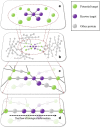An integrated strategy for identifying new targets and inferring the mechanism of action: taking rhein as an example
- PMID: 30189851
- PMCID: PMC6127921
- DOI: 10.1186/s12859-018-2346-4
An integrated strategy for identifying new targets and inferring the mechanism of action: taking rhein as an example
Abstract
Background: Target identification is necessary for the comprehensive inference of the mechanism of action of a compound. The application of computational methods to predict the targets of bioactive compounds saves cost and time in drug research and development. Therefore, we designed an integrated strategy consisting of ligand-protein docking, network analysis, enrichment analysis, and an experimental surface plasmon resonance (SPR) method to identify and validate new targets, and then used enriched pathways to elucidate the underlying pharmacological mechanisms. Here, we used rhein, a compound with various pharmacological activities, as an example to find some of its previously unknown targets and to determine its pharmacological activity.
Results: A total of nine candidate targets were discovered, including LCK, HSP90AA1, RAB5A, EGFR, CDK2, CDK6, GSK3B, p38, and JNK. LCK was confirmed through SPR experiments, and HSP90AA1, EGFR, CDK6, p38, and JNK were validated through previous reports. Rhein network regulations are complex and interconnected. The therapeutic effect of rhein is the synergistic and comprehensive result of this vast and complex network, and the perturbation of multiple targets gives rhein its various pharmacological activities.
Conclusions: This study provided a new integrated strategy to identify new targets of bioactive compounds and reveal their molecular mechanisms of action.
Keywords: Enrichment analysis; Ligand-protein docking; Network analysis; Rhein; SPR; Target identification.
Conflict of interest statement
Ethics approval and consent to participate
Not applicable
Consent for publication
Not applicable
Competing interests
The authors declare that they have no competing interests.
Publisher’s Note
Springer Nature remains neutral with regard to jurisdictional claims in published maps and institutional affiliations.
Figures






Similar articles
-
Predicting new molecular targets for rhein using network pharmacology.BMC Syst Biol. 2012 Mar 21;6:20. doi: 10.1186/1752-0509-6-20. BMC Syst Biol. 2012. Retraction in: BMC Syst Biol. 2014;8:105. doi: 10.1186/s12918-014-0105-3. PMID: 22433437 Free PMC article. Retracted.
-
An integrated network pharmacology and cell metabolomics approach to reveal the role of rhein, a novel PPARα agonist, against renal fibrosis by activating the PPARα-CPT1A axis.Phytomedicine. 2022 Jul 20;102:154147. doi: 10.1016/j.phymed.2022.154147. Epub 2022 May 6. Phytomedicine. 2022. PMID: 35567992
-
StemCellCKB: An Integrated Stem Cell-Specific Chemogenomics KnowledgeBase for Target Identification and Systems-Pharmacology Research.J Chem Inf Model. 2016 Oct 24;56(10):1995-2004. doi: 10.1021/acs.jcim.5b00748. Epub 2016 Oct 7. J Chem Inf Model. 2016. PMID: 27643925 Free PMC article.
-
[Network pharmacology and drug discovery].Sheng Li Ke Xue Jin Zhan. 2011 Aug;42(4):241-5. Sheng Li Ke Xue Jin Zhan. 2011. PMID: 22066413 Review. Chinese.
-
A Comprehensive and System Review for the Pharmacological Mechanism of Action of Rhein, an Active Anthraquinone Ingredient.Front Pharmacol. 2016 Aug 17;7:247. doi: 10.3389/fphar.2016.00247. eCollection 2016. Front Pharmacol. 2016. PMID: 27582705 Free PMC article. Review.
Cited by
-
SPRD: a surface plasmon resonance database of common factors for better experimental planning.BMC Mol Cell Biol. 2021 Mar 6;22(1):17. doi: 10.1186/s12860-021-00354-w. BMC Mol Cell Biol. 2021. PMID: 33676410 Free PMC article.
-
An overview of COVID-19 with an emphasis on computational approach for its preventive intervention.3 Biotech. 2020 Oct;10(10):435. doi: 10.1007/s13205-020-02425-9. Epub 2020 Sep 16. 3 Biotech. 2020. PMID: 32959007 Free PMC article. Review.
-
Aloin induced apoptosis by enhancing autophagic flux through the PI3K/AKT axis in osteosarcoma.Chin Med. 2021 Nov 24;16(1):123. doi: 10.1186/s13020-021-00520-4. Chin Med. 2021. PMID: 34819120 Free PMC article.
References
MeSH terms
Substances
Grants and funding
LinkOut - more resources
Full Text Sources
Other Literature Sources
Research Materials
Miscellaneous

